                  |
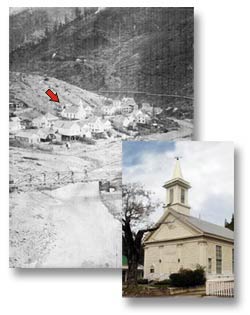 Methodist
Church of Downieville Methodist
Church of Downieville
Construction of the Methodist Church of Downieville also began
in 1853, the same year as the First Catholic Church. However,
the Methodist church, which also served as the area's Episcopal
church, was not completed until 1856, This original structure
is still in use today and is now California's oldest Protestant
church building in continuous use. Prior to the church being constructed,
the town's folk were holding Sunday services in other buildings.
The construction site of the Methodist Church of Downieville had
not been mined, so once construction was complete, the property
was mined via tunneling – once using gravel to support the
foundation and again using dirt that had to be taken in by wheel
barrow.
Of all the gold mined from
beneath the Methodist church, the congregation never received
any of the profits. A new floor was constructed in 1960, at which
time a cavity 7 feet in diameter and several feet deep was discovered.
No wonder the church's foundation had continued to settle so drastically,
causing such continued necessary repairs. Not even churches were
sacred when it came to gold mining in the 1800's.
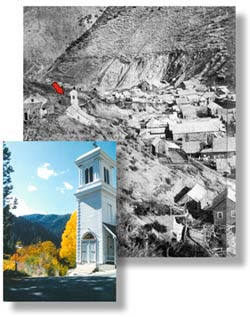 The
First Catholic Church of Downieville The
First Catholic Church of Downieville
was a simple structure built in 1853 under the direction of Father
Shanahan, a priest who had visited the mining camp after a devastating
fire in 1852 had burned down most of the communities buildings.
The church was active even though
it didn’t have a permanent pastor. Father Dalton traveled
frequently from Grass Valley to the northern corners of Sierra
County, including to Downieville when in 1856 he purchased a former
Baptist church for $2,300. On June 22, 1856, the church was dedicated
as “The Assumption.” In the winter of 1856,
Father Charles Delahunty became pastor of the Downieville parish.
When that building burned down on
Jan. 1, 1858, Father Delahunty had the present church built up
the hill, approximately 150 yards north of the former site and
dedicated this new structure as “The Immaculate Conception.”
While guarding his own flock, Father
Delahunty also traveled to the many other mining towns of Sierra
County until 1861, when he was transferred to Virginia City.
To this day, The Immaculate Conception
Church still serves the residents of Downieville.
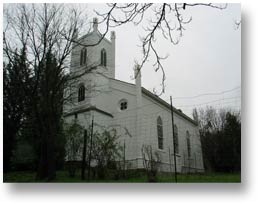 Emmanuel
– Coloma Emmanuel
– Coloma
The towering Emmanuel Church in Coloma was constructed beginning
in 1855 and completed in 1856, six years after the Episcopal congregation
was formed. There are no records of where the church members met
prior to the presence of the new building. The township's mission
work began in 1849 with the arrival of Rev. William Roberts and
continued with Silas F. Bennett, who continued later that year
after being sent to Coloma by General John Sutter to complete
the mill. A newspaper article, dated Sept. 29, 1855 reads:
The Ladies of Emmanuel Church will hold a Ladies’ Fair
Oct. 5. The attendance of a great number of ladies from adjoining
towns is anticipated and gentlemen will do well to make note of
the time.
In 1870, the building became the Methodist-Episcopal Church. In
1921, the Methodists took ownership of the property and building
and that year made extensive improvements. The church was in use
as a house of worship until 1963 when it was deeded to the California
State Parks division.
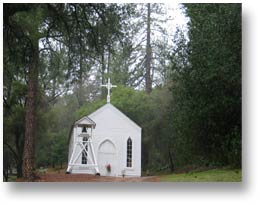 St.
John's – Coloma St.
John's – Coloma
St. John's Catholic Church is not the congregation's original
meeting place. A small log church was built in 1856 but as the
membership grew the need for a larger building was fulfilled in
1858 with the construction of this standing building. Unfortunately
this little church fell into severe disrepair as the fortunes
and citizens of Coloma dwindled over the next century. It was
successfully rescued in 1972 when it was lovingly restored. The
original bell, cast in Sheffield, England in 1860, remains in
the bell tower and the original stone foundation was built so
tightly that no mortar was needed. It also remains in tact. Inside,
some of the fine original pews have been polished to a beautiful
luster and the Stations of the Cross are still in place. Behind
the church is the Catholic Cemetery, which contains 77 graves.
The first date of burial is 1850, that of D.A. MacPhee, so the
cemetery began before the church building was erected. Coloma's
St. John's Catholic Church and the Emanuel Church are just a stone’s
throw from each other on Church Street.
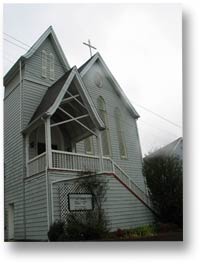 Placerville
Episcopal Placerville
Episcopal
Through the efforts of a young man by the name of Rev. Charles
Caleb Pierce, Placerville's Episcopal Church was erected in 1865,
four years after the Catholic Church was built. Originally a Quaker,
Rev. Pierce was apparently a popular man. There are records of
the Pierce Ladies Guild who raised money and received donations
in order to build the church that still sits on Coloma Street
right near today's Highway 50. In their efforts to collect enough
money to finish the church, Pierce received $1,500, which came
from four saloonkeepers. The profession of saloon keeping was
not held in high esteem, yet after their donations Rev. Pierce
had this to say: “There are some excellent and high principled
saloonkeepers, as I can attest.” Placerville's Episcopal
Church is still in use today.
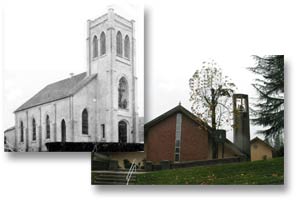
Placerville Catholic Church
“A substantial frame church was erected on Sacramento Street,”
according to an 1852 document that records the first semblance
of a Catholic Church in Placerville, then called Dry Diggins.
The original name came from the fact that there was not much water
with which to mine the gold. After three men were hanged from
an oak tree in the middle of town, the community was hung with
the unofficial moniker of Hangtown. Lawlessness soon became much
less of a problem because of the name. But since the townsfolk
were too crazy about their nickname, it officially changed to
Placerville in 1854.
The new, modern church you see today stands on the same spot as
the original but still another building was on that sight in between.
The first building was destroyed by fire in 1865. All that was
left of it was the beautiful bell, which had been a gift from
some miners. It was cast with a considerable amount of silver
in it. A new church went up in August 1865. Dry Diggins’
first Catholic priest was a missionary by the name of F. Ingoldsby,
who arrived in town in 1852.
At least two other historic churches, dating from the mid-1800s,
graced Placerville but they fell into such severe disrepair, they
were eventually demolished in the 20th century.
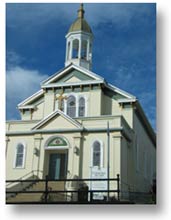 St.
Patrick Catholic Church & Rectory - Jackson St.
Patrick Catholic Church & Rectory - Jackson
Daniel Harter and his carpenters built this graceful church on
Church Street in downtown Jackson in 1868. However, local Catholics
had been gathering for mass in various homes since 1852. In 1853,
Armstead C. Brown sold them his former residence, which they had
been using for church services and it sufficed until 1855 when
a new church was built. The 1862 fire consumed that building and
in 1868 the current church took its place. A new bell arrived
in 1870 but in 1878, it was blown down along with the belfry and
cross, which wasn’t replaced until 1894. Part of the accompanying
rectory was added next door in 1887; with another half added some
time after 1919. St. Patrick’s Catholic Church continues
to house its faithful to this day.
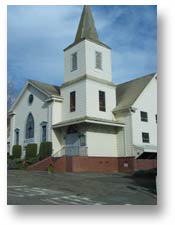 Methodist
Church & Parsonage - Jackson Methodist
Church & Parsonage - Jackson
The original Methodist-Episcopal Church was built in 1853, however
the same denominations were erected in Fort John, Volcano and
Ione prior to Jackson's. The building survived the 1862 fire because
it was far enough away from the blaze. In 1968, the wood structure
was demolished to make room for the present brick construction.
The existing parsonage next door was constructed in 1893. Thanks
to a 23-year-old minister, Isaac B. Fish, and his seemingly frail
and delicate wife, the Methodist-Episcopal church was finally
a reality in Jackson. Fish traveled by foot (he could not afford
to own or feed a horse) to Jackson from Mokelumne Hill and surrounding
communities beginning in 1851. He preached in homes, frequently
to less than a handful of people. During one sermon, a knife fight
broke out. Fish declared of Jackson: “The Lord have mercy
on the wicked people of Jackson.” But his persistence finally
paid off.
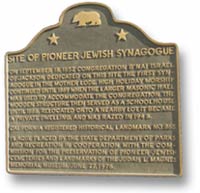 Pioneer
Jewish Synagogue - Jackson Pioneer
Jewish Synagogue - Jackson
While Jewish tradesmen, peddlers and merchants arrived in Jackson
in 1849, it wasn't until September 1857 that the Mother Lode's
first Jewish Synagogue was dedicated and opened for the first
time. In July 1857, the Amador Ledger reported: “The
Israelites of Jackson have commenced the construction of what
will be, when finished, one of the largest and finest churches
in the mountains.” John Edwards, of Ione Valley, and A.C.
Brown, of Jackson, donated the land on which the synagogue stood,
surrounded by the Jewish cemetery. Historians believe that the
synagogue was only used for annual high holy days each September
and was left locked the rest of the year. After 1868, the building
was used for secular purposes and was demolished in 1876, just
19 years after it's construction. Today a monument to the Jewish
Synagogue stands in front of the Jackson Grammar School on Church
Street. (Courtesy of Larry Cenotto)
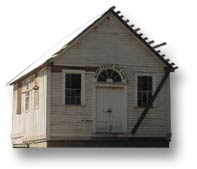 St.
Peter and Paul's - Jackson St.
Peter and Paul's - Jackson
The tiny, crude church of St. Peter and Paul's was originally
built in the town of Clinton, south of Jackson. Mere signs of
Clinton no longer exist. Believed to have been built in 1877,
the small building was moved to the Kennedy Mine site, in the
town of Jackson in the last few years. Also relocated at the Kennedy
Mine site is a Jackson bridge originally built in 1908. St. Peter
& Paul's church can be visited at the mine site on Jackson
Gate Road. (Courtesy of Larry Cenotto)
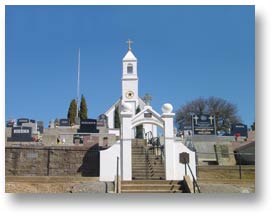 St.
Sava Serbian Church – Jackson St.
Sava Serbian Church – Jackson
On a hillside in Jackson, in a neighborhood once known as Newmanville,
stands the spectacular St. Sava Serbian Church, built in 1894.
Majestic headstones in the cemetery surround the massive snow-colored
church. St. Sava (pronounced Saba) was the first Serbian Church
built in North America to serve the spiritual needs of the countless
Serbian miners who came to the Gold Country to pluck their riches.
Prior to the church's construction, the “Slavonian Benevolent
Society” was formed in Sutter Creek between 1872 and 1874,
depending on which historical account you read. After their Sutter
Creek “church meeting place” burned down in 1881,
Jackson became their focal point. Construction was completed in
December 1894 using brick fired in Jackson. Originally planned
as a “Greek Orthodox” church, the Serbian/Slavonian
residents were successful in procuring a Serbian charter and thus
became the mother church of North America.
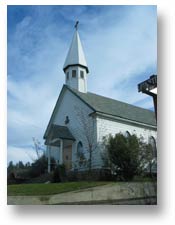 The
Mokelumne Hill Community Church The
Mokelumne Hill Community Church
celebrates its 152nd birthday in 2005, with old
and new members invited. The church was built in 1853 as the Congregational
Church and was headed by Rev. Benjamin D. Henry, of Maine. The
original building burned down in the fire of 1854 and the church
that visitors see today was
built and dedicated in 1856. Services
have taken place in this church continuously over the last century
and a half.
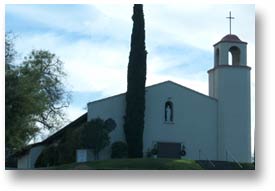 The
Catholic Church in San Andreas The
Catholic Church in San Andreas
began with the transfer of raw land from Charles H. Schroebel
and Daniel Pillsbury to three men known only as Dennis, Wyllie
and Dunning. The land transfer was recorded on April 6, 1857.
Dennis, Wyllie and Dunning paid $250 for the property on which
to build the existing church. It is located on, where else but
Church Street. Heading north on Hwy 49, turn right at the only
flashing yellow light in San Andreas and the church is directly
ahead.
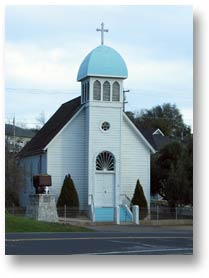 Serbian
Church - Angels Camp Serbian
Church - Angels Camp
The intriguing architecture of Angels Camp's Serbian Church is
one of the best-restored and most consistently maintained churches
in the southern Mother Lode. Sitting on the left side of the road
on Highway 49 that runs south directly through Angels Camp, this
delightful structure has been photographed more frequently than
Elizabeth Taylor. This smaller Serbian congregation was under
the guidance of the larger congregation in Jackson.
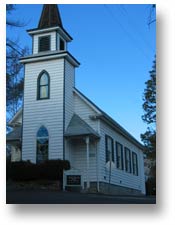 First
Congregational Church of Murphys First
Congregational Church of Murphys
The quaint white church in Murphys’ historic hamlet began
with a small group of Protestant's gathering in a home for Sunday
services in 1853. There were 10 members to be exact. By 1866,
a church that was already built at the present site in 1853, became
the permanent home of the First congregational Church of Murphys.
It wasn't until 1885 that the church was legally incorporated.
A new church, on the current site, was built in 1895 as the old
one was becoming unsafe. The cost of the new building, the one
seen today, was $1,622 with much of the labor and materials having
been donated.
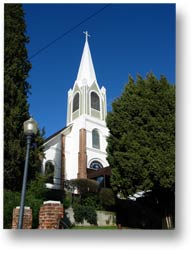 St.
Patrick's Catholic Church – Sonora St.
Patrick's Catholic Church – Sonora
St. Patrick's Catholic Church, located at 116 W. Bradford Street,
in Sonora was built in 1875. Another church, constructed in 1863,
stood in this same spot. St. Patrick's has been in continuous
use since its construction and is still used to this day.
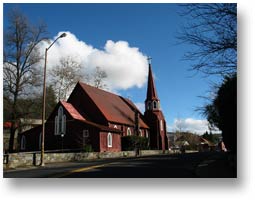 "The
Red Church" - Sonora "The
Red Church" - Sonora
Everyone who lives in the Gold Country refers to Sonora's red
church as “The Red Church” for obvious reasons. Constructed
of bright red bricks and standing out at a protruding corner downtown,
the church is actually St. James Episcopal Church. It was built
in 1860.
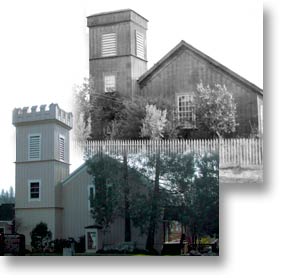 49er
Church – Columbia 49er
Church – Columbia
Like many other churches in the historic Highway 49 Gold Country,
churches are known by a common name to the locals but are actually
affiliated with a specific denomination. Such is the case of the
Presbyterian Church in the well-preserved town of Columbia, which
is now a State Historic Park. Located at the corner of Jackson
Street and Gold Street, The Presbyterian Church is affectionately
known to area residents and historians as “The Church of
the 49ers.” Gold was first discovered in Columbia on March
27, 1850. In 1854, 15 pioneers and the Rev. John Brodt gathered
to organize the “First United Presbyterian Church of Columbia.”
They met in the former Methodist church, a tiny building that
sat at the same location. The Church of the 49ers was completed
in 1864. The original building burned to the ground in 1950, 86
years later, at which time an exact replica was constructed following
the old records and photographs. In December 2004, a second mortgage
of $100,000 was paid off so the note was burned to celebrate the
group's 150th year. - Courtesy of Tuolumne County Museum
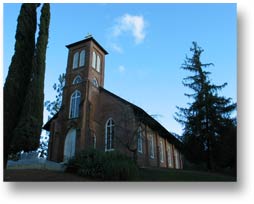 St.
Ann's – Columbia St.
Ann's – Columbia
The stunning St. Ann's Church, just outside of the Columbia State
Historic Park, is believed to be the oldest standing original
church structure in the entire Mother Lode. The towering brick
building features arched windows on all four sides with a nearly
three-story tall belfry. The bell, at a cost of $1,500, was cast
in New York and brought around the Horn. The front of the churchyard
serves as the church's cemetery. Twice St. Ann's Catholic Church
has undergone major restoration: first in 1926, and again in a
three-phase project from 1979 through 1982. After the completion
of phase two, the doors re-opened on Christmas Eve, 1980. - Courtesy
of Tuolumne County Museum
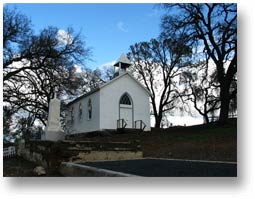 Chinese
Camp Chinese
Camp
Built in 1855, the St. Francis Xavier Church in Chinese Camp is
thought to be the second oldest surviving Roman Catholic Church
in the Mother Lod St. Ann's Church in Columbia is the oldest.
Although very little remains of the community of Chinese Camp,
the wood-frame church, which sits on a dry stone foundation, is
in much the same condition as it was 150 years ago. Even a few
of the original pews remain inside which are constructed with
square nails. The churchyard serves as one of two cemeteries in
the area; with the earliest know burial in 1862. Only a few alterations
have been made to the building itself beginning in 1948 when the
belfry was removed and a new door replaced the old back door,
however the original lock and key are still in use. Church services
have not been held in St. Francis Xavier since the 1920s, however
in 1952 “High Noon” was filmed in Chinese Camp with
the church in some of the scenes. The western, considered to be
one of the all-time best, starred Thomas Mitchell, Gary Cooper,
Harry Morgan, Lloyd Bridges, Grace Kelly and Lon Chaney.
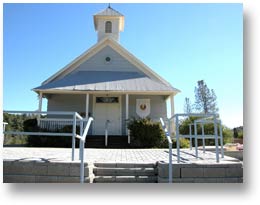 Our
Lady of Mt. Carmel Our
Lady of Mt. Carmel
has served the folks of the Big Oak Flat and Groveland areas since
it was dedicated in 1860. As in most early mining camps, a fire
roared through Big Oak Flat in 1863 and destroyed every wooden
structure except this little church at the top of the hill.
As the population of the area fluctuated several times from the
1860s to today, so did membership at Our Lady of Mt. Carmel. Placer
mining gave out in the late 1860 so the population dropped. It
grew again in the 1890s with the advent of hard-rock mining. After
another drop in residents, more people moved there in 1916 with
the construction of the Hetch Hetchy Water & Power Project.
Still in use continuously, the church was extensively refurbished
in 1977, and 1988 saw the addition of a 16-foot extension. During
lean years, mass was held once a month, frequently only if there
was a fifth Sunday in the month.
|


 Methodist
Church of Downieville
Methodist
Church of Downieville The
First Catholic Church of Downieville
The
First Catholic Church of Downieville  Emmanuel
– Coloma
Emmanuel
– Coloma St.
John's – Coloma
St.
John's – Coloma Placerville
Episcopal
Placerville
Episcopal
 St.
Patrick Catholic Church & Rectory - Jackson
St.
Patrick Catholic Church & Rectory - Jackson Methodist
Church & Parsonage - Jackson
Methodist
Church & Parsonage - Jackson  Pioneer
Jewish Synagogue - Jackson
Pioneer
Jewish Synagogue - Jackson  St.
Peter and Paul's - Jackson
St.
Peter and Paul's - Jackson  St.
Sava Serbian Church – Jackson
St.
Sava Serbian Church – Jackson The
Mokelumne Hill Community Church
The
Mokelumne Hill Community Church The
Catholic Church in San Andreas
The
Catholic Church in San Andreas Serbian
Church - Angels Camp
Serbian
Church - Angels Camp  First
Congregational Church of Murphys
First
Congregational Church of Murphys St.
Patrick's Catholic Church – Sonora
St.
Patrick's Catholic Church – Sonora "The
Red Church" - Sonora
"The
Red Church" - Sonora  49er
Church – Columbia
49er
Church – Columbia St.
Ann's – Columbia
St.
Ann's – Columbia Chinese
Camp
Chinese
Camp Our
Lady of Mt. Carmel
Our
Lady of Mt. Carmel